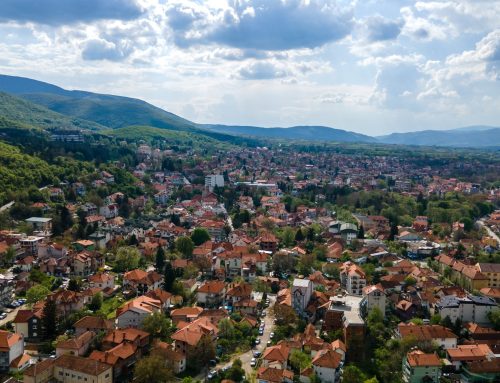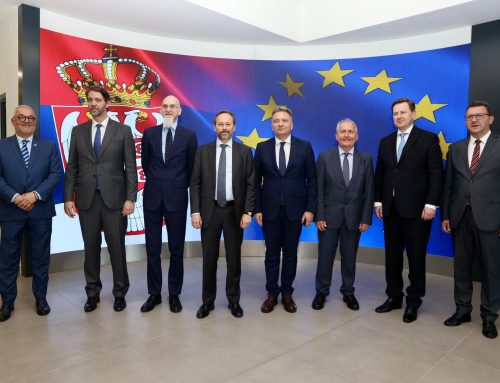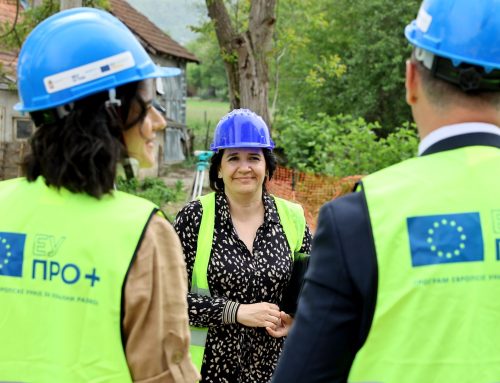The representatives of the EU Member States, the Western Balkans and Turkey, the European Commission and the European Central Bank, as well as representatives of the central banks of the Western Balkans and Turkey, gathered today in Brussels for the annual economic policy dialogue. The meeting is part of the strengthened dialogue on economic governance between the EU and the Western Balkans and Turkey aimed at efficiently preparing participants for their future participation in the EU’s economic policy coordination procedures.
The representatives concluded the meeting with a series of country-specific targeted guidelines. The conclusions for Serbia positively assess the Economic Reform Programme, expecting the economy to expand further at 3.5%-4.0% in 2019-2021. The growth should be based on growth in exports, private consumption and investments. Nevertheless, downside risks also need to be considered, particularly due to the slowdown of external demand from main trading partners. The monetary policy was well conducted and inflationary pressures kept in check. There is a need to further increase government capital spending in support of long-term growth, properly anchor good fiscal results, reform the system of public wages and strengthen the system of fiscal rules. The banking sector is well capitalised and liquid, while the overall ratio of non-performing loans (NPLs) declined considerably. With the public and private investments still remaining low, the economy requires further transformation in order to become more competitive. The main challenges include improving transparency and predictability in the regulatory environment, ensuring fair competition, and fully liberalising the energy market. The contribution of labour to growth needs to be increased, and women, youth and recent graduates need to be better integrated into the labour market.
In the joint conclusions Serbia is invited to implement six recommendations: (1) maintain the medium-term budgetary objective close to balance, contain the overall spending on wages and pensions, and implement the public sector wage system reform; (2) increase capital spending supporting long-term growth, also by establishing a single investment mechanism for prioritising and monitoring all investments regardless of the source of financing, and strengthen the fiscal responsibility framework by improving the fiscal rules system; (3) continue promoting the use of the local currency, implement the measures of the programme for resolving non-performing loans (NPLs) and the related action plan, and finalise the privatisation and restructuring process of the remaining state-owned banks; (4) finalise a new industrial strategy, adopt specific legislation on the alternative investment vehicles and ensure timely consultation of businesses and social partners on all new legislation drafts concerning their operations; (5) gradually adjust electricity tariffs to reflect actual costs and finalise unbundling of state-owned energy enterprises, in particular fully implement the unbundling of Srbijagas and EMS and complete the functional unbundling of EPS in a compliant manner, as well as provide a third-party access to gas infrastructure; (6) substantially increase the funding and provision of active labour market measures tailored to women and young people in particular, adopt incentive measures to formalise labour in non-agricultural sectors and reduce the high non-wage labour cost of jobs at the lower sections of the wage distribution.
Serbian Minister of Finance Siniša Mali said: Serbia has successfully consolidated its public finances and has established a solid basis for further growth. Last year, we attracted 3.5 billion euros of FDIs, and only in the first four months of this year we have achieved an increase of 14% in comparison to the same period last year. The focus of the economic and fiscal policy in the coming period will be on preserving fiscal stability and public debt reduction. This will set a scene for further improvement of the economic enviroment and lead to a more robust increase of FDIs and resillience of our economy. We want to support further job creation, especially for young people, and to secure better positioning of the country in the region and beyond.
Sem Fabrizi, the EU Ambassador to Serbia stressed “it is very positive that Serbia maintained macroeconomic and fiscal stability in 2018. A result that is expected also in the future. The joint Economic Reform Programme conclusions stress that it is particularly important to lock in recent gains and give stronger impetus to structural reforms. Implementing the well-designed set of reforms contained in the 2019-2021 Economic Reform Programme will be crucial for maintaining the positive growth figures, to make the business environment even more attractive to investors, domestic and foreign alike, and to ensure that the positive effects of the economic growth become more inclusive.”
Ambassador Fabrizi pointed to some of the main challenges, including tackling corruption, the high share of the informal economy, strengthening the rule of law and an inadequate institutional check and balances system.
“The EU will continue supporting Serbia in its efforts to reform the economy, increase competitiveness and improve the rule of law by implementing the measures listed in the Economic Reform Programme. Their implementation will enhance further the strong economic relations with the EU who is by far the main trade partner (63% of total trade) and first investor (73% of FDI) of Serbia”
Governor Jorgovanka Tabaković highlighted that inflation in Serbia has been at a low level for more than half a decade. “Serbia has also recorded a sharp fall in the NPL ratio. Besides, with our measures we have supported two-digit growth in corporate and household lending, and via this channel, we supported economic growth as well.” In addition to low inflation, the key factors driving FDIs to Serbia are relative stability of the exchange rate and the results achieved on the fiscal front and in many other areas. Governor Tabaković assessed that political stability is also critical in terms of attracting investment, and this Serbia has. Governor Tabaković said that during the last four years FDI inflows in Serbia stood at around 6% of GDP on average, while last year alone they reached 8.2% of GDP, providing for full coverage of the current account deficit. Governor Tabaković underlined: “I believe that the integration in infrastructure flows, the latest technological projects and innovations, in line with our potentials, are the basis for Serbia’s growth. At the same time, this is the basis for investment. And our potentials are the geographic position and work force. It is up to us to provide macroeconomic stability and equal treatment for all investors.”
For more information:
Official statement after the meeting from the DG NEAR website




